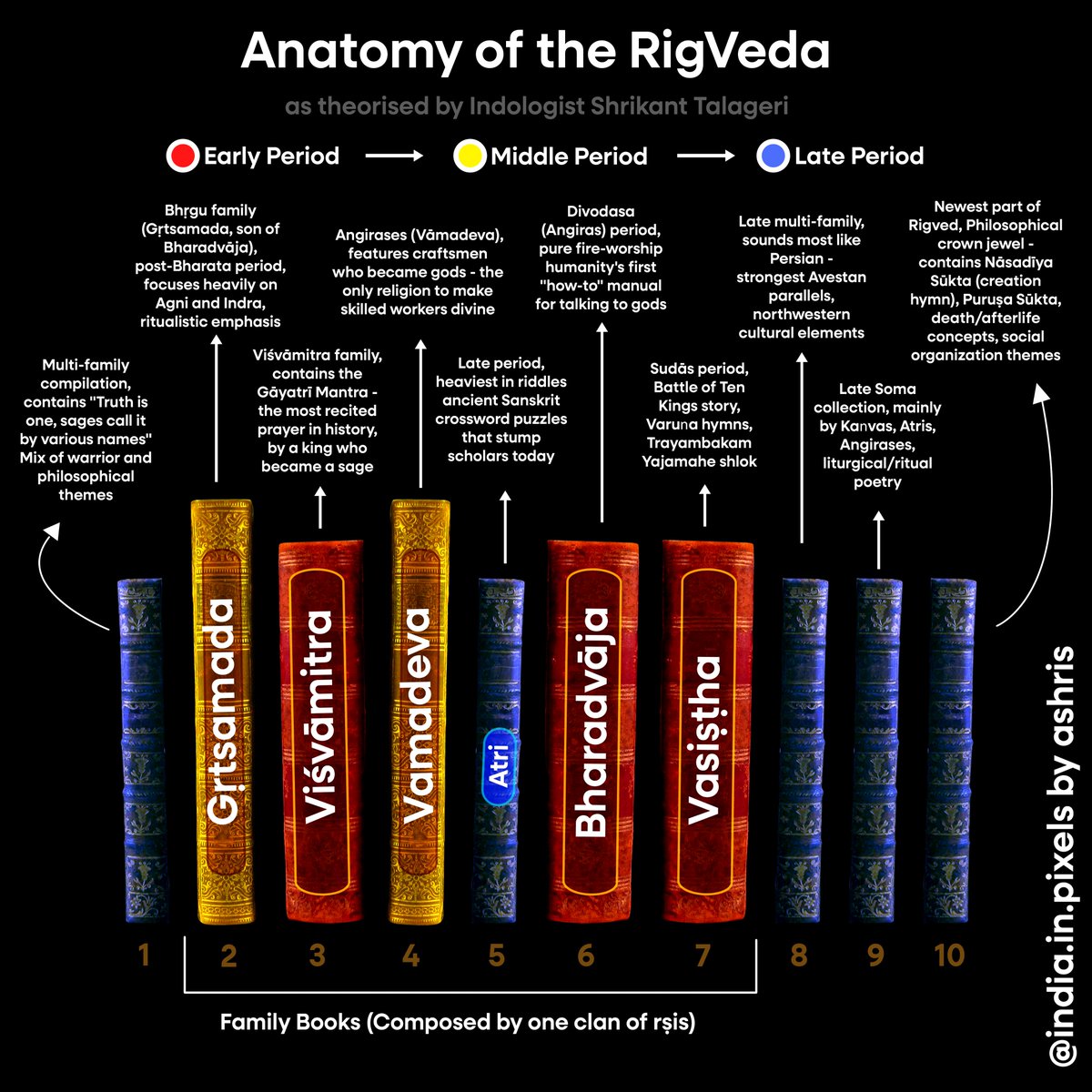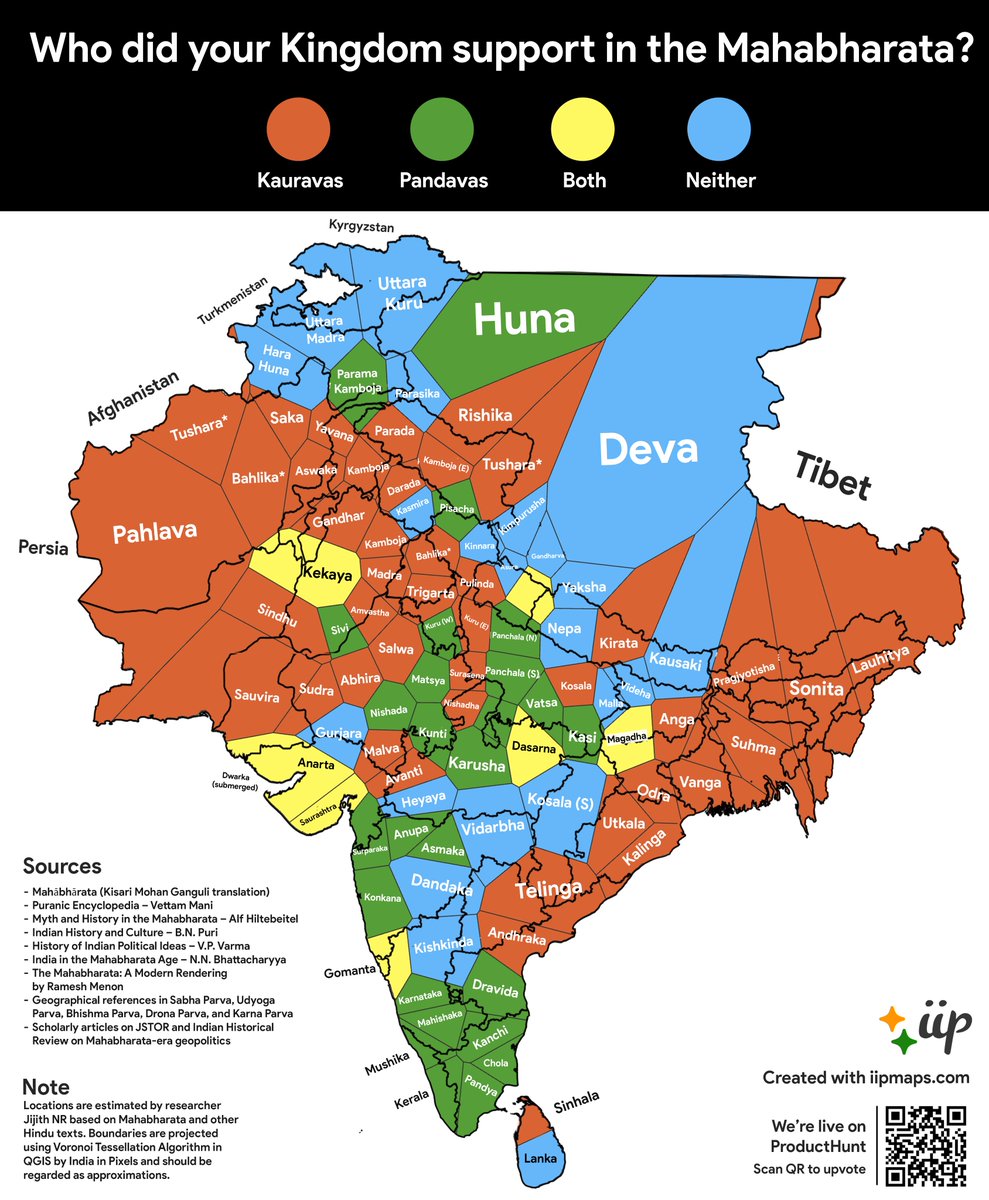The Rigveda, the oldest of the Vedas, has been dated anywhere from the timeless to the early Iron Age. Unlike the Mahabharata, it lacks a clear historical anchor, so its age has been debated through astronomy, archaeology, linguistics, and tradition.
Hindu orthodoxy treats the Vedas as apauruṣeya, eternal revelations. Dayanand Sarasvati insisted they were created at the dawn of each cosmic cycle, most recently in 3102 BCE, making historical dating irrelevant.
Others push the hymns into deep prehistory. Nilesh Oak uses star positions to argue for skies as old as 22,000 BCE, with strong fits around 6000–5000 BCE. Sudhir Bhargava, using Puranic genealogies, places the Rigveda at 8000 BCE, while Subhash Kak links it to the Indus–Sarasvati civilization (7000–3000 BCE). David Frawley, too, interprets astronomical markers as proof of a long growth stretching from before 6000 down to 2000 BCE.
Late nineteenth century scholars also turned to the sky. Bal Gangadhar Tilak’s The Orion dated the hymns to about 4500 BCE, while his later Arctic Home in the Vedas imagined Aryans at the pole. Hermann Jacobi suggested 3500–2500 BCE and P. C. Sengupta even tied a hymn to a specific eclipse on 26 July 3928 BCE.
Archaeology places the text closer to the Bronze Age. B. B. Lal argued that the Rigveda must predate the drying of the Sarasvati river (c. 2000 BCE), making it contemporary with Harappan civilization (2600–1900 BCE).
Most Western scholars, however, cluster in the second millennium. Max Müller suggested 1200 BCE as a minimum, admitting it was guesswork. Thomas Oberlies pushed the oldest hymns to around 1700 BCE and the youngest to 1100 BCE. Michael Witzel tied the text to Indo-Aryan clans between 1500 and 1200 BCE, with compilation around 1000 BCE. David Anthony linked Rigvedic culture to steppe migrations and the spread of horses and chariots around 1500 BCE. Romila Thapar situates it between 1500 and 1000 BCE, after Harappan decline and during the rise of early pastoral polities.
Genetics has recently reinforced this consensus. The study by Narasimhan et al. (2019) shows steppe ancestry entering South Asia between 1900 and 1500 BCE, suggesting the Rigveda was composed after these migrations.
Across this wide range, the Rigveda becomes a mirror of scholarly perspective: eternal revelation, Ice Age astronomy, Harappan continuity, or Indo-European migration. The debate is less about one date than about the very story scholars choose to tell of India’s beginnings.
Hindu orthodoxy treats the Vedas as apauruṣeya, eternal revelations. Dayanand Sarasvati insisted they were created at the dawn of each cosmic cycle, most recently in 3102 BCE, making historical dating irrelevant.
Others push the hymns into deep prehistory. Nilesh Oak uses star positions to argue for skies as old as 22,000 BCE, with strong fits around 6000–5000 BCE. Sudhir Bhargava, using Puranic genealogies, places the Rigveda at 8000 BCE, while Subhash Kak links it to the Indus–Sarasvati civilization (7000–3000 BCE). David Frawley, too, interprets astronomical markers as proof of a long growth stretching from before 6000 down to 2000 BCE.
Late nineteenth century scholars also turned to the sky. Bal Gangadhar Tilak’s The Orion dated the hymns to about 4500 BCE, while his later Arctic Home in the Vedas imagined Aryans at the pole. Hermann Jacobi suggested 3500–2500 BCE and P. C. Sengupta even tied a hymn to a specific eclipse on 26 July 3928 BCE.
Archaeology places the text closer to the Bronze Age. B. B. Lal argued that the Rigveda must predate the drying of the Sarasvati river (c. 2000 BCE), making it contemporary with Harappan civilization (2600–1900 BCE).
Most Western scholars, however, cluster in the second millennium. Max Müller suggested 1200 BCE as a minimum, admitting it was guesswork. Thomas Oberlies pushed the oldest hymns to around 1700 BCE and the youngest to 1100 BCE. Michael Witzel tied the text to Indo-Aryan clans between 1500 and 1200 BCE, with compilation around 1000 BCE. David Anthony linked Rigvedic culture to steppe migrations and the spread of horses and chariots around 1500 BCE. Romila Thapar situates it between 1500 and 1000 BCE, after Harappan decline and during the rise of early pastoral polities.
Genetics has recently reinforced this consensus. The study by Narasimhan et al. (2019) shows steppe ancestry entering South Asia between 1900 and 1500 BCE, suggesting the Rigveda was composed after these migrations.
Across this wide range, the Rigveda becomes a mirror of scholarly perspective: eternal revelation, Ice Age astronomy, Harappan continuity, or Indo-European migration. The debate is less about one date than about the very story scholars choose to tell of India’s beginnings.
Sources:
Dayanand Sarasvati, Satyarth Prakash (1875).
Bal Gangadhar Tilak, The Orion (1893); The Arctic Home in the Vedas (1903).
P. C. Sengupta, Ancient Indian Chronology (1947).
Subhash Kak, The Astronomical Code of the Rigveda (1994).
David Frawley, Gods, Sages and Kings (1991).
Nilesh Oak, When Did the Mahabharata War Happen? (2011).
B. B. Lal, The Rigvedic People (2002).
Thomas Oberlies, Die Religion des Rgveda (1998).
Michael Witzel, “Early Sanskritization: Origins and Development of the Kuru State” (1995).
David Anthony, The Horse, the Wheel, and Language (2007).
Romila Thapar, Early India: From the Origins to AD 1300 (2002).
V. Narasimhan et al., “The formation of human populations in South and Central Asia,” Science 365, 2019.
Dayanand Sarasvati, Satyarth Prakash (1875).
Bal Gangadhar Tilak, The Orion (1893); The Arctic Home in the Vedas (1903).
P. C. Sengupta, Ancient Indian Chronology (1947).
Subhash Kak, The Astronomical Code of the Rigveda (1994).
David Frawley, Gods, Sages and Kings (1991).
Nilesh Oak, When Did the Mahabharata War Happen? (2011).
B. B. Lal, The Rigvedic People (2002).
Thomas Oberlies, Die Religion des Rgveda (1998).
Michael Witzel, “Early Sanskritization: Origins and Development of the Kuru State” (1995).
David Anthony, The Horse, the Wheel, and Language (2007).
Romila Thapar, Early India: From the Origins to AD 1300 (2002).
V. Narasimhan et al., “The formation of human populations in South and Central Asia,” Science 365, 2019.
• • •
Missing some Tweet in this thread? You can try to
force a refresh















